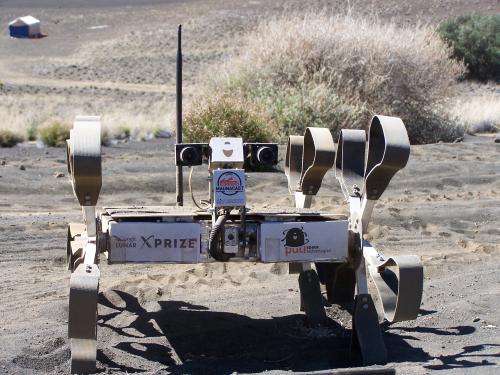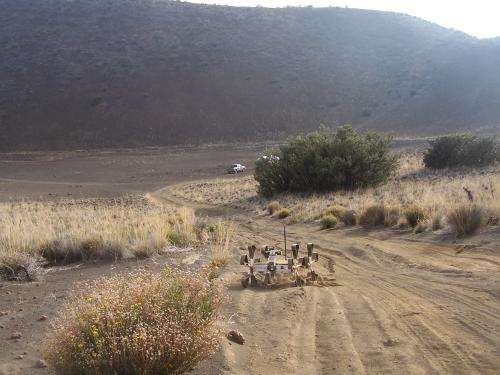Hungarian rover takes 'panoramic selfie' to complete Google Lunar XPRIZE mission simulation in Hawaii

Team Puli, the Hungarian team competing for the Google Lunar XPRIZE, has completed a successful simulation of its lunar rover mission at the Pacific International Space Centre for Exploration Systems (PISCES) in Hawaii. During field tests, the Puli rover drove 600 meters across soft, loose soil similar to the lunar regolith and broadcast high-resolution images and video from its starting and end points. To claim the Google Lunar XPRIZE, a team must land a robotic craft on the Moon and explore the lunar surface, covering a distance of at least 500 meters, as well as transmit footage and pictures back to Earth of the landing site, the journey and final resting site.
The new PISCES facility, which opened in early 2013, is located on the slopes of Mauna Kea. Its volcanic soil and terrain is widely acknowledged as being among the closest analogs to lunar regolith found on Earth.
During 8 days of testing during December at the PISCES lunar analog site, the Puli team verified several core aspects of their Google Lunar XPRIZE mission. These included the planning processes for the rover's route from the landing site using satellite imagery, testing the rover's mobility across lunar analog terrains with slopes up to 40 degrees in places, and trialling the Mission Control software, both for the rover and with a second vehicle playing the part of the landing craft for the simulation. Mission Control for the simulation was located in Budapest Town Hall, Hungary, from where Team Puli will control its actual Google Lunar XPRIZE attempt.
"The Puli rover has a unique wheel-leg (wheg) construction, designed explicitly for rough terrain," explained Puli team leader Dr. Tibor Pacher. "This is not the first time that Puli has been tested in analog sites – we took part in a field test in Morocco in early 2013 – but the PISCES facility offers the most challenging and realistic scenario that our rover has faced to date. To simulate the Mooncast that we will need to transmit back from the Moon, we have completed a 'Maunacast' with panoramic shots of our start and finish sites, waypoint identifications and distant verifications. We are delighted with how the Puli rover has performed."

Members of Team Puli had already visited the PISCES facility in their role as mentors to the Hungarobots, the winning team of the 2012 MoonBots LEGO Mindstorms Challenge. The Hungarobots, who are students at a high school in Sopron, Hungary, won a VIP trip to test their LEGO lunar robots at the PISCES facility, which has a strong commitment to education and public outreach.

"Because of Hungary's strong traditions in engineering and science I saw huge opportunities in a Hungarian Google Lunar XPRIZE project to create sustainable values – in education and society as well as engineering," said Pacher. "Team Puli was extremely happy and proud last year when the junior version of the Google Lunar XPRIZE competition, MoonBots, was won for the first time by a European – Hungarian – team. Through initial contacts made during the Hungarobots trip to PISCES, we have developed further links with PISCES and are now testing the hardware for our actual lunar mission here. Our participation in a STEM project has not only provided an inspirational opportunity for the students, but has actually helped us in reaching our goal to send a spacecraft to the Moon."
Provided by XPRIZE


















